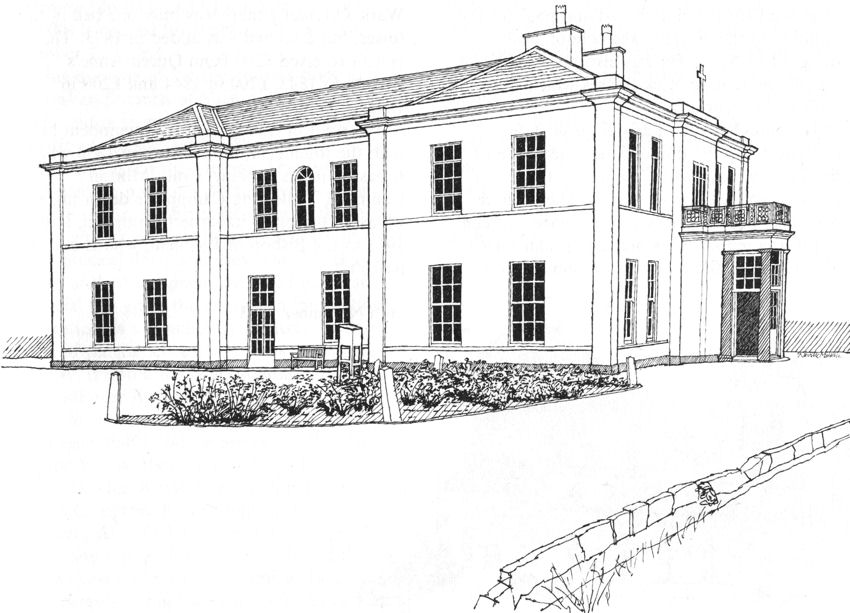|
|
|
![]() back to "The Grand Tour" index
back to "The Grand Tour" index
Neville Malkin's "Grand Tour" of the Potteries
buildings South of the Potteries
![]()
![]()
![]()
next: Holy Trinity
Church, Hartshill
previous: The Mount, Penkhull
contents: index of
buildings south of the Potteries
|
No 17 - St. Dominic's High School, Hartshill
- now demolished - photo: © The Potteries
Museum & Art Gallery Later a new school was built neared the convent and in 1988 the house was demolished. Now a small housing estate sits on the site of the house. Much of the grounds and some of the ponds are still in existence as Hartshill Park. |

St. Dominic's High School,
Hartshill
pen drawing by Neville Malkin - Oct 1975
|
"On the western
side of Stoke, in a commanding position overlooking the Fowlea valley,
stands Cliffeville, a blue, stuccoed Georgian mansion, now occupied by
St. Dominic's High School, a school founded in 1857 at the nearby
Dominican Convent. The land on which it stands was formerly part of the royal demesne of Cliff Hay mentioned in "Testa de Nevill," subsequently called Castle Cliff and belonging to the King's Woods. In 1365 a considerable part of the estate was granted by John of Gaunt, Duke of Lancaster, to two Burgesses of Newcastle, Hugh Bowyer and William Brompton. By 1615 it was being let for ley land to a tenant who paid 13s. 4d. yearly for the pasturage. In 1810, approximately 70 acres was purchased by John Tomlinson, a solicitor, who had acquired a considerable fortune since opening his practice in Hanley in 1794. On this land he erected Cliffeville, described as "an elegant mansion of stone". It was the largest freehold estate in the area. Following his death, the house and estate passed to his younger son, Frederick Wright Tomlinson, whose eldest son, the Rev. John Wickes Tomlinson, was Rector of Stoke. Caroline, his only daughter, married Major Sir Lovelace Stamer, of Dublin, and the house and estate eventually passed into the possession of the Stamer family. In 1898 it was bought by Alderman Frederick Geen, Mayor of Stoke, who sold part of the grounds with ornamental ponds to a laundry, and another part for the widening of the Stoke-Newcastle road. Although the estate was dwindling in size it still retained a great deal of beauty, and in 1913, when King George V and Queen Mary visited the Potteries, they took lunch at Cliffeville with the Mayor. The Geens continued to live at the mansion until about 1920 when the neighbouring Catholics acquired the house and grounds for about £5,000. An extra £2,000 was spent on converting the property into a school."
|
|
The mansion known as Cliffe
Ville (or Cliff Ville) was built by John Tomlinson, a solicitor, in 1808.
It became Geen's home where, in 1913, he entertained King George V and
Queen Mary when they formally opened the Kings Hall in Stoke. In 1922 the
house was acquired by the nuns at the nearby Dominican Convent and became
St. Dominic's High School.
"The area designated as Hartshill Park has a varied history of land use. During the Domesday period it formed part of a vast deer park, Cliff Hay, mentioned in 1204. Hart is the name of a male deer and these were bred for the King to hunt in mediaeval times. Hartshill as a place name is recorded in the 16th century. The park was also known as Castle Cliff because it was part of the royal manor of Newcastle and its oak trees were used to repair the castle there. It still existed in the 15th century because the hedges and posts which enclosed it were repaired then. The area the present park occupies is formed from the remains of two estates - Cliff Vale and Hartshill Farm." "The mansion known as Cliff Ville was built by John Tomlinson, a solicitor, in 1808. John Tomlinson died in 1838. In April 1864, F.W. Tomlinson is registered as owning 13 acres of freehold. Cliffeville then passed to the Stamer family. In 1892 the sale of Cliffeville was authorised under the act of 1889. See p.186 'A History of the County of Stafford vol. VIII J.G. Jenkins' for sources." "A grotto where a statue
of Our Lady was placed during religious festivals and processions still
stands in a commanding position at the top of the pools. |
next: Holy Trinity Church, Hartshill
previous: The Mount, Penkhull
contents: index of buildings south of the Potteries
back to "The Grand Tour" index